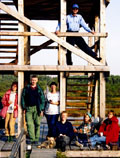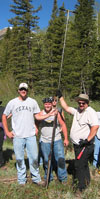Teamwork in Geosciences
Professor Emeritus James S. Aber
Emporia State University
Background
In the typical college science course, students may conduct laboratory exercises, go on field trips, write term papers, and take final exams. In most cases, students participate and are graded as individuals; in fact, students feel strong pressure to compete with each other to achieve higher grades. This continues the pattern they have experienced throughout their academic careers since grade school. As students move into their own senior undergraduate, master's and doctoral research programs, they are increasingly evaluated, again, as individuals.
In contrast, nearly all actual science is undertaken in teams or groups in which individuals cooperate to achieve a research goal. Modern science is conducted within large organizations—universities, governmental agencies, engineering and scientific corporations—with substantial financial commitments from federal and state governments, charities, private trusts, company stockholders, venture capitalists, etc. From this brief discussion, it's clear that the normal academic preparation of science students bears little resemblance the actual practice of science.
Modern geoscience publication
Scientific accomplishment is evaluated on the basis of peer-reviewed publications. Take a look at the current issue of the Bulletin of the Geological Society of America, one of the premier geoscience journals in North America.
 GSA Bulletin.
GSA Bulletin.
Chances are, most or nearly all of the articles have multiple coauthors. The September 2010 issue, for example, had 24 articles on subjects ranging from Precambrian tectonics to Pleistocene alluvial fans. Of these, only two articles were written by single authors. All the others (22) had two or more coauthors, many had at least five coauthors, and one had 15 coauthors. This is absolutely typical of modern geoscience. The number of coauthors is even greater in some other disciplines.
The days of the lone scientist working long hours in the laboratory or field on his or her own are long gone. Science, like most other human endeavors, is a cooperative venture normally pursued in teams or groups of individuals who collaborate on a common project or problem. The people may work together closely on a daily or frequent basis. In other cases, collaboration may be intermittent with long gaps between sharing information or reviewing each other's work.

| Members of the Estonian field crew at the observation tower in Männikjärve bog; relaxing after a long day of kite aerial photography. From left to right: Karin Muru, Edgar Karofeld, Susie Aber, Kai Kimmel, Katrin Möllits, and Kiira Aaviksoo; J.S. Aber at top. Not shown: Andres Kimmel and Meeli Vilbaste. Right: aerial view of the observation tower.
| 
|
As a general rule, the first author did most of the actual writing of the journal article or book, but everyone who made significant contributions to the project is given credit as coauthors. In fact, one or more of the coauthors may have been crucial contributors toward successful outcome of the research. In other cases, some coauthors played mere cameo roles. For some situations, the last author is actually the most important! The relative importance of coauthors is usually impossible to know just from reading the article, however. Taken all together, the published article represents a team project.
Faculty career
The author's own career has followed a trajectory toward more team projects and group research in three phases. Post-doctoral and junior faculty work was mostly independent, as with the traditional college student model. During a middle phase, increasingly large international projects developed along side continuing individual research. In the third phase, nearly all significant scientific work has involved group projects. Representative publications illustrate these developmental phases.
-
Post-doctoral and junior faculty
- Aber, J.S. 1979. Glacial conglomerates of the Appalachian Plateau, New York. Quaternary Research 11, p. 185-196.
- Aber, J.S. 1979. Kineto-stratigraphy at Hvideklint, Møn, Denmark and its regional significance. Geological Society Denmark, Bulletin 28, p. 81-93.
- Aber, J.S. 1985. The nature of glaciotectonism. Geologie en Mijnbouw 64, p. 389-395.
Mid-career scientific phase
- Aber, J.S., Croot, D.G. and Fenton, M.M. 1989. Glaciotectonic landforms and structures. Glaciology and Quaternary Geology Series, Kluwer Academic Publishers, Dordrecht, the Netherlands, 200 p.
- Aber, J.S. 1991. The glaciation of northeastern Kansas. Boreas 20, p. 297-314.
- Aber, J.S., Bluemle, J.P., Brigham-Grette, J., Dredge, L.A., Sauchyn, D.J. and Ackerman, D.L. 1995. Glaciotectonic map of North America, scale 1:6,500,000. Geological Society of America, Maps and Charts Series, MCH079.
Senior scientific phase
- Aber, J.S., Wallace, J. and Nowak, M.C. 2002. Response of forest to climatic events and human management at Fort Leavenworth, Kansas. Kansas Geological Survey, Current Research in Earth Sciences, Bulletin 248, part 1. See full article.
- Aber, J.S., Marzolff, I., Ries, J.B. and Aber, S.E.W. 2019. Small-format aerial photography and UAS imagery: Principles, techniques and geoscience applications, 2nd ed. Elsevier, Amsterdam, 268 p. See book details.
Student group projects
Nearly all students have some anxiety about group projects, because this means interacting with other students, who may not be their friends or may not even be known to them beforehand. This situation especially affects distance-learning students. Nonetheless, becoming proficient with team projects is essential for further professional development and eventual careers in science.
Effective communication is the key to any successful group project. This does not necessarily mean daily contact, but frequent contact among team members is important as well as prompt replies to queries or suggestions from other team members. Many means exist nowadays—ranging from in-person meetings to online chatting and video conferencing. The mode of communication needs to be established early on and should match the technical capability of all members.

| ESU field geology students collect a core sample from a peat bog at Bear Lake, near Cuchara, Colorado. The basal peat was sent to a radiocarbon laboratory where it was dated 3630 to 3700 calendar years old (Beta 2007).
|
Students often have quite varied academic, work, family, and leisure schedules, particularly distance-learning students, who may live in several different time zones. The whole group needs to agree on a shared means for communication, and do not expect instantaneous feedback—asynchronous communication may be the best mode for some groups. Most importantly, make sure to copy all members when sending updates, questions, or suggestions—everybody needs to be involved as the project moves forward. Some web sites support collaborative work.
- Google Docs for creating and sharing documents.
- Collanos for sharing documents, online discussions, etc.
Reference
- Beta Analytic Radiocarbon Dating Laboratory (2007). Sample 232587.
Please send your comments to the author, J.S. Aber.
jaber@g.emporia.edu. Last update: 2020. GSA Bulletin.
GSA Bulletin. GSA Bulletin.
GSA Bulletin.